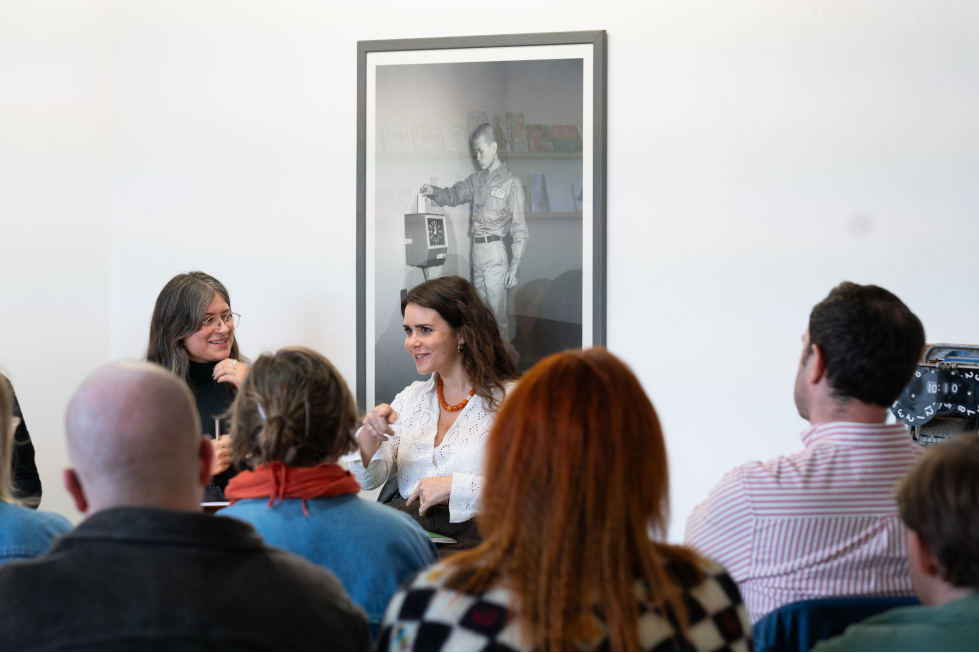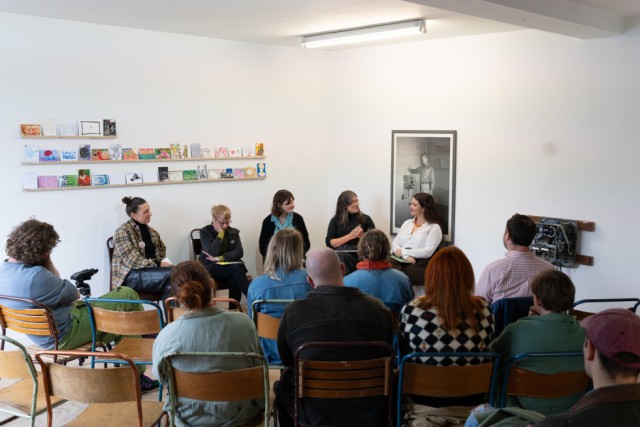“Artists Are Not Bloody Machines.” Dispatches from the Structurally
F–cked Panel Discussion

Earlier this year, the Structurally F–cked report revealed damning evidence of artists’ pay and conditions. At a panel discussion during Middlesbrough Art Week, Mike Pinnington heard how the hard work is only just beginning…
Back in 2020, deeply frustrated at a lack of transparency about (and the often very poor rates of) artists’ pay, Industria submitted a Freedom of Information Request to Tate. They’d hoped, anticipated even, that it would shed light on pay structures for artists. Instead, the response when it came was that it would not be in the ‘commercial interest’ of the organisation to do so.
Concerned by this lack of openness, they set up Artist Leaks, an anonymous online survey of visual artists, which sought to hear first-hand about the realities of working in the sector. After a slow start came a steady trickle of responses, leading, in March this year, to the publication of the report which became Structurally F–cked: an inquiry into artists’ pay and conditions in the public sector in response to the Artist Leaks data.
It exposed in detail the depth and breadth of the problem, including the shocking if not entirely surprising revelation of a median hourly rate paid to artists of just £2.60. (Contrast this with the current National Living Wage – 21 and over – of £ 11.44.)
Compounding this was the testimony, which provided the report with its title, that: “The expectation to overdeliver is unspoken and loud. Everybody overcommits and as the artist you’re at the bottom of the food chain and expected to do your ‘magic’ in a system that is structurally f–cked.”
It wasn’t simply low pay, then; the report also pointed to a wider, extensive issue of systemic exploitation and general poor treatment of artists. Cue bucket-loads of hand-wringing coverage in industry press and national newspapers. In the immediate aftermath, faced with the stark nature of the bare facts and figures (confirming, incidentally, what many already knew), people, quite rightly, were up in arms.
But after the publication of so damning a report: what next? How to keep the conversation going and, if possible, gather meaningful momentum? In October, in the months after the dust had settled and some in the art world had moved on, a panel convened by Middlesbrough Art Week met to discuss the report to continue the dialogue so that the research isn’t squandered.
Industria were joined by artist/designer/arts organiser Jenny Mcnamara, representing artists’ membership organisation, a-n, and researcher and industry commentator, Dr Susan Jones, author of a doctoral thesis on artists’ pay and, pertinently, what can be done about it.
Moderator, curator Penny Payne, began by asking Mcnamara about a-n’s involvement with the commissioning of the report, and the value of its outcomes. “The biggest thing, for me, was making artists feel like they’re not alone,” she said. “Easy to think ‘It’s me, I’m not tough enough for this industry; maybe I need to leave it or retrain? I’m a failure.’ Something that comes across in the report is that it’s not individual, it’s systemic, and I think that’s really powerful.”
The sentiment was echoed by Industria, who said that “all the bits that aren’t about money, that feel individual, that make you feel shit as an artist, to do with [expenses, insurance, etc.], the actual treatment of artists… when that’s alongside being paid badly, why are [you surprised that] artists are throwing the towel in so often, or that the backgrounds that artists are coming from is shrinking?”

An informed and engaged audience regularly chipped in; one making the point that, while the Industria research paints a picture of the barriers faced by artists in this moment, it’s far from a new problem. Primed, Susan Jones said: “It’s fascinating to find, and sad, that we keep turning the wheel that says there’s something wrong about artists’ pay… it’s not just money; it’s their social status that’s at stake here. Talking about money unfortunately clouds the issue, because organisations only talk about money – they are so instrumentalised, that’s all they consider. ‘How many people can we get through the door, how many cups of coffee can we sell, how many reviews can we get in the art newspaper…’ that’s what they’re counting. Not,” she concludes, “the quality of their relationship with artists.”
Artists, most will agree, shouldn’t be fighting for scraps, only to find that when they’re (often very briefly) granted a place at the table, it is – for many – already bare. As Jones asserted: “Artists are so valuable to the visual arts infrastructure; they are the material who produce everything for everybody else’s career.”
It’s a point that can get lost in the wash of ‘big art’. As Jones said, the industry is overflowing with “people, sitting, talking amongst themselves, about the importance of [the] arts, and the importance of themselves, within the arts… This trickle-down system doesn’t work; where you give the money to the organisations, and they will look after artists – they aren’t, they don’t, they never will!”
It’s damning stuff, and gains traction in the room as talk turns to those in the sector that we might describe as arts adjacent – or the middlemen/people. McNamara, an infrequent but insightful contributor to the panel, observed: “the income difference between salaried arts workers and artists is enormous. So much money in the system is being lost to the middleman.”
Jones, by now central to the conversation and increasingly on hand with a great stat, responds: “There has been a 42% increase in the number of visual arts occupations between 1997 and 2017. 42%. People say: ‘Oh, the reason artists are poor is because there’s just too many artists – right?’ No, it’s not there’s too many artists; there are too many middle people. The percentage of artists is actually smaller, and there are no more artists now than there were in 1985.”
A thread develops at this point, that the body whose declared vision it is for “England to be a country in which the creativity of each of us is valued and given the chance to flourish”, Arts Council England, is regularly failing those who most need its support. From a chronic lack of research and development funding, to seemingly actively making applying for already competitive funding difficult to the point of deterrence, the consensus emerged that ACE, all too frequently, was more problem than part of the solution.
From the audience comes the bleak, but nonetheless reasonable perspective, that: “There’s a learned helplessness. We feel there’s nothing we can do… [Therefore] things can’t change, and things will never change.”
So, what’s to be done? How, asked Payne, can we build on the data? For the report’s authors: “it was always about trying to slightly radicalise, or bring some consciousness to people that hadn’t been working in the arts so long. We wanted to bring it to people that maybe hadn’t had that conversation bubble up yet.” Among other things, Structurally F–cked calls for “a transformation of society”, for institutions and commissioners to advocate and make the case for increased funding, and that commissioners commit to paying artists at least minimum wage.
Very reasonable, and you’d think, achievable goals that we can all agree on. But there’s also the acknowledgement that there’s no silver bullet. “There are incremental things we can do to make artists’ lives slightly better in this moment. We’re not just shouting from the grass roots ‘burn it all down’, this is actually how we can offer small things that we’ve had in conversations with artists, these are things that others are saying. Small offerings to make our lives slightly more bearable when moving through this system.”
“I often think about the seeming impossibility of the artists’ strike. You can build solidarity,” offers McNamara. “Nowadays,” concurs Jones, “you could do a strike in all sorts of interesting demonstrative ways. If you think of how successful campaigners were at getting sponsorship from BP removed at the Tate… You could create a solidarity manifested in different ways at any one time.”
But, owing to the exhausting competition, churn and precarity I know many of you reading this will be all too familiar with, solidarity isn’t explicit among freelancers and the self-employed – especially when fighting to keep your head above water. A fact acknowledged when a member of the audience says that: “in theory that’s great.” But: “here, there’s people in this room, that if I turn down [an] opportunity, people will do it for free. They will take the free gig.”
It’s as clear as ever that there’s much to be done; guarding against complacency, Jones warns: “So much energy can be dissipated. We’ve all had a good chat, and then we’re all going to go home and it’s going to be somebody else’s job to do something about it. We’ve got to say: how am I going to activate this? How am I going to make this happen?”
But, she concluded, “The bottom line is that the government is not going to be shovelling a lot more money into the arts. There’s been a 40% drop off in audiences to arts venues. They’re clinging on by their fingertips. So, the question is, are they the right venues? Do we need those kinds of venues? Should we think of redeploying infrastructural sums of money and build an infrastructure that truly values the making and the participation in the arts that is meaningful for the next generation? It’s the next generation we have to be thinking about, it’s the generation beyond you. The country deserves better. It deserves art for art’s sake, made by artists who are allowed to be artists. We are not bloody machines.” Nor should artists be expected to be entrepreneurs, certainly not as a primary role, or at the expense of making.
There is no quick fix to the findings outlined by Industria, but it’s helpful and unquestionably important that it has been put back on the agenda and under the noses of those who can affect change. But also for a generation of, one hopes, newly radicalised artists. The problem lies with a creaking, underfunded, and bloated, system. Artists shouldn’t be driven out of the sector or into dire straits because of its failures. The resounding message from both panel and those in attendance today: we must keep talking, challenging, and organising.
Mike Pinnington
Mike attended the Industria: Structurally F–cked roundtable discussion at The Auxiliary Project Space on 5 October as part of Middlesbrough Art Week
Images: © Rachel Deakin





